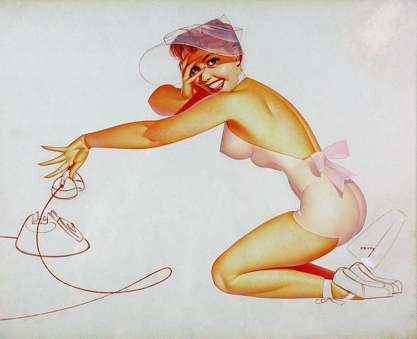 |
| Above: Full view of September 1956 Petty Girl |
 |
| Above: The overlaid artist’s signature lower right |
A dazzling original George Petty Girl pin-up painting used in 1956 for an Esquire Magazine calendar, caption reads, “I goof in the kitchen, At “listening” I’m bad. According to theorists Nary a lad should be interested. Man, are those theorists mad!”
 |
| Above: Detail |
 |
| Above: Nicely matted and framed |
George Petty’s enormously successful career as an illustrator began in the mid-1920s painting magazine covers and images of beautiful girls for calendars. The creation that made him legendary debuted in the first issue of Esquire magazine in 1933. The “Petty Girl,” with her dreamy curves and witty banter, quickly became a popular symbol of the American male’s feminine ideal. In addition to her eagerly anticipated appearances in Esquire, the Petty Girl also began emerging in major advertising campaigns, such as Janzten (swim suits) and Old Gold Cigarettes. By the time Petty and Esquire parted company over irreconcilable differences in 1940, (and Esquire replaced him with Alberto Vargas), the Petty Girl had become an indelible image in the American culture and commercial market.
With the outbreak of World War II, the Petty Girl did her part for the war effort by boosting morale. During this same period Petty produced several memorable images for the Ziegfeld Follies and covers for Ice Capades programs. In 1947 he began working with True magazine, a relationship that would prove advantageous for both artist and publisher. Hollywood, never missing a popular trend, released The Petty Girl in 1950. Esquire produced two other calendars by Petty in 1955 and 1956.
This painting appeared as the September Petty Girl in the 1956 Esquire calendar, and later in a special Petty portfolio and article by Esquire. These works proved so popular that lighters were issued adorned with the images–one of these lighters is included in the sale.
 |
| Above: Verso of frame with Printed 1956 tear sheet |
 |
| Above: Petty Girl lighter with this image created to coincide with immense popularity of “The Petty Girl” |
Rendered in watercolor, this illustration is signed lower right. Note: On all of their 1955 and 1956 Petty calendar originals, Esquire moved the signatures for publication, after print use the artist moved the signature up to the right hand top corner at some point so it could be re-used for commercial use, the signature is again placed where it was originally on the lower right corner and it is adhered and on a separate piece of illustration board as is generally the case with Petty originals.

